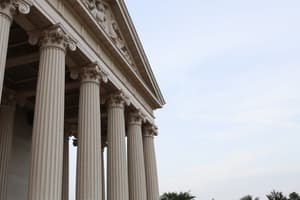Podcast
Questions and Answers
What is an arch?
What is an arch?
- A curved structure made of wedge-shaped stones (correct)
- A decorative panel on a ceiling
- A type of column
- A flat structure made of wood
What is the base of a column?
What is the base of a column?
The lowest supporting part of a column.
Define a bay in architectural terms.
Define a bay in architectural terms.
A regularly repeated spatial unit of a building.
What does the capital of a column refer to?
What does the capital of a column refer to?
Classical architecture refers only to the architecture of ancient Greece.
Classical architecture refers only to the architecture of ancient Greece.
What is classicism?
What is classicism?
What is a coffer?
What is a coffer?
What is a colonnade?
What is a colonnade?
Describe a column in classical architecture.
Describe a column in classical architecture.
What characterizes the Corinthian order?
What characterizes the Corinthian order?
What is a cornice?
What is a cornice?
What is a dome?
What is a dome?
What defines Doric columns?
What defines Doric columns?
What is an entablature?
What is an entablature?
What does the term 'facade' refer to?
What does the term 'facade' refer to?
Define a flute in architecture.
Define a flute in architecture.
What is the characteristic of Ionic columns?
What is the characteristic of Ionic columns?
What does Neoclassicism refer to?
What does Neoclassicism refer to?
What is an order in classical architecture?
What is an order in classical architecture?
What is a pediment?
What is a pediment?
What is a portico?
What is a portico?
What does revival mean in architectural terms?
What does revival mean in architectural terms?
Define a rotunda.
Define a rotunda.
What is a shaft in the context of a column?
What is a shaft in the context of a column?
What is a vault?
What is a vault?
What is a volute?
What is a volute?
What does asymmetry mean in architecture?
What does asymmetry mean in architecture?
Define eclecticism in architecture.
Define eclecticism in architecture.
Flashcards are hidden until you start studying
Study Notes
Classical Architecture Vocabulary
-
Arch: A curved structure made of wedge-shaped stones (voussoirs) that spans an opening, often used for structural support.
-
Base: The lowest supporting part of a column that stabilizes it.
-
Bay: A spatial unit in a building, defined by columns, walls, or windows, often repeated regularly.
-
Capital: The uppermost part of a column, which transitions between the column and horizontal elements, providing additional support. Notable example includes the Corinthian capital with acanthus leaves.
-
Classical: Refers to the architecture styles originating from ancient Greece and Rome.
-
Classicism: Ancient architectural forms and principles derived from Greek and Roman influences.
-
Coffer: A decorative panel that is sunken square or polygonal, commonly found in ceilings.
-
Colonnade: A series of columns arranged in a row that supports a beam or entablature; seen in structures like The Vatican.
-
Column: A cylindrical support featuring a base, shaft, and capital, either monolithic or composed of cylindrical pieces (drums).
-
Corinthian: The most ornate of the three classical orders, characterized by capitals adorned with acanthus leaves and scrolls.
-
Cornice: A decorative molding at the top of a building that overhangs to protect the structure below.
-
Cupola: A small dome, frequently positioned atop a roof or minor tower.
-
Dome: A rounded, convex ceiling or roof structure supported by a circular or polygonal base.
-
Drum: Refers to a circular wall supporting a dome or a cylindrical block that forms a column.
-
Doric: The most robust of the classical orders featuring a plain capital, fluted shaft, and lacking a base.
-
Entablature: The upper section of a classical order, composed of three parts and supported by columns.
-
Facade: The principal exterior face of a building, often the front.
-
Flute: A concave vertical groove running along the shaft of a column.
-
Ionic: A slender architectural order distinguished by its volute (scroll-like) capital.
-
Neoclassicism: An artistic movement that emerged in late 18th-century Europe, characterized by a revival of classical styles.
-
Order: A style of classical column and entablature, of which the Greeks developed three types: Doric, Ionic, and Corinthian.
-
Pediment: A triangular gable typically found at the end of a Greek or Roman temple, also used above doors and windows as an ornamental feature.
-
Portico: An entranceway or porch supported by columns on one or more sides, a hallmark of classical architecture.
-
Revival: The act of reusing architectural styles from previous eras in new designs.
-
Rotunda: A round building or hall, generally topped with a dome.
-
Shaft: The vertical portion of a column located between the base and capital.
-
Vault: An arched construction that forms a ceiling or roof, typically made from masonry.
-
Volute: A spiral or scroll-shaped design element, often found in Ionian capitals.
-
Asymmetry: A design principle where balance is achieved through uneven distribution of elements around a fulcrum.
-
Eclecticism: An architectural approach that combines styles and elements from various sources to create a unique design.
Studying That Suits You
Use AI to generate personalized quizzes and flashcards to suit your learning preferences.




